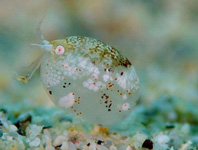Abstract
Turritopsis fascicularis Fraser, 1943 was first described off Alligator Reef, Florida, USA, at a depth of 216 m. Presumably a deep-sea species, its validity has often been questioned due to the scarcity of available records. In this paper, T. fascicularis is re-described from some mature colonies from the upper slope of the Gulf of Mexico. Furthermore, new pictures of the colony, polyps, and medusa buds, are provided. A ~600bp sequence of the large ribosomal subunit of the mitochondrial RNA (lsu-rRNA, 16S), also known as the Hydrozoan barcoding molecule, is used for the first time to confirm the validity of T. fascicularis as a species, and analyze its phylogenetic position within the genus Turritopsis.
References
Calder, D. (1988) Shallow-water hydroids of Bermuda. The Athecatae. Royal Ontario Museum Life Sciences Contributions, 148, 1–107.
http://dx.doi.org/10.5962/bhl.title.52225Calder, D.R. (1991) Abundance and Distribution of Hydroids in a Mangrove Ecosystem at Twin-Cays, Belize, Central-America. Hydrobiologia, 216, 221–228.
http://dx.doi.org/10.1007/BF00026466Calder, D.R. (1993) Local distribution and biogeography of the hydroids (Cnidaria) of Bermuda. Caribbean Journal of Science, 29, 61–74.
Calder, D.R. (1998) Hydroid diversity and species composition along a gradient from shallow waters to deep sea around Bermuda. Deep-Sea Research Part I-Oceanographic Research Papers, 45, 1843–1860.
http://dx.doi.org/10.1016/S0967-0637(98)00044-2Calder, D.R. (2013) Some shallow-water hydroids (Cnidaria: Hydrozoa) from the central east coast of Florida, USA. Zootaxa, 3648 (1), 1–72.
http://dx.doi.org/10.11646/zootaxa.3648.1.1Cartwright, P., Evans, N.M., Dunn, C.W., Marques, A.C., Miglietta, M.P., Schuchert, P. & Collins, A.G. (2008) Phylogenetics of Hydroidolina (Hydrozoa: Cnidaria). Journal of the Marine Biological Association of the United Kingdom, 88, 1663–1672.
http://dx.doi.org/10.1017/S0025315408002257Cunningham, C.W. & Buss, L.W. (1993) Molecular evidence for multiple episodes of paedomorphosis in the family Hydractiniidae. Biochemical Systematics and Ecology, 21, 57–69.
http://dx.doi.org/10.1016/0305-1978(93)90009-GDefenbaugh, R.E. & Hopkins, S.H. (1973) The occurrence and distribution of the hydroids of the Galveston Bay, Texas area. Information Center for Marine Resources, Texas A&M University, College Station, Texas, TAMU-SG-73-210, 1–202.
Edgar, R.C. (2004) MUSCLE: multiple sequence alignment with high accuracy and high throughput. Nucleic Acids Research, 32, 1792–1797.
http://dx.doi.org/10.1093/nar/gkh340Felsenstein, J. (1985) Confidence-Limits on Phylogenies - an Approach Using the Bootstrap. Evolution, 39, 783–791.
http://dx.doi.org/10.2307/2408678Fraser, C.M. (1943) Distribution records of some hydroids in the collection of the Museum of Comparative Zoology at Harvard College, with description of new genera and new species. Proceedings of the New England Zoological Club, 22, 75–98.
Fraser, C.M. (1944) Hydroids of the Atlantic coast of North America. The University of Toronto press, Toronto, 451 pp.
Haddad, M.A., Bettim, A.L. & Miglietta, M.P. (2014) Podocoryna loyola, n. sp. (Hydrozoa, Hydractiniidae): a probably introduced species on artificial substrate from southern Brazil. Zootaxa, 3796 (3), 494–506.
http://dx.doi.org/10.11646/zootaxa.3796.3.5Kimura, M. (1980) A Simple Method for Estimating Evolutionary Rates of Base Substitutions through Comparative Studies of Nucleotide-Sequences. Journal of Molecular Evolution, 16, 111–120.
Maddison, D.R. & Maddison, W.P. (2003) MacClade 4 (version 4.06): Analysis of phylogeny and character evolution. Available from: http://macclade.org (accessed 29 February 2016)
Miglietta, M.P. & Lessios, H.A. (2009) A silent invasion. Biological Invasions, 11, 825–834.
http://dx.doi.org/10.1007/s10530-008-9296-0Miglietta, M.P., Piraino, S., Kubota, S. & Schuchert, P. (2007) Species in the genus Turritopsis (Cnidaria, Hydrozoa): a molecular evaluation. Journal of Zoological Systematics and Evolutionary Research, 45, 11–19.
http://dx.doi.org/10.1111/j.1439-0469.2006.00379.xMilne, I., Wright, F., Rowe, G., Marshall, D.F., Husmeier, D. & McGuire, G. (2004) TOPALi: software for automatic identification of recombinant sequences within DNA multiple alignments. Bioinformatics, 20, 1806–1807.
http://dx.doi.org/10.1093/bioinformatics/bth155Moura, C.J., Harris, D.J., Cunha, M.R. & Rogers, A.D. (2008) DNA barcoding reveals cryptic diversity in marine hydroids (Cnidaria, Hydrozoa) from coastal and deep-sea environments. Zoologica Scripta, 37, 93–108.
Rambaut A. (2014) FigTree. 2014. v.1.4.2: tree drawing tool. Available from: http://tree.bio.ed.ac.uk/software/figtree/ (accessed 29 February 2016)
Schuchert, P. (2004). Revision of the European athecate hydroids and their medusae (Hydrozoa, Cnidaria): families Oceanidae and Pachycordylidae. Revue suisse de Zoologie, 111 (2), 315–370.
http://dx.doi.org/10.5962/bhl.part.80242Schuchert, P. (2007) The European athecate hydroids and their medusae (Hydrozoa, Cnidaria): Filifera Part 2. Revue Suisse de Zoologie 114, 195–396.
http://dx.doi.org/10.5962/bhl.part.80395Tamura, K., Stecher, G., Peterson, D., Filipski, A. & Kumar, S. (2013) MEGA6: Molecular Evolutionary Genetics Analysis Version 6.0. Molecular Biology and Evolution, 30, 2725–2729.
http://dx.doi.org/10.1093/molbev/mst197Wendt, P.H., Knott, D.M. & Van Dolah, R.F. (1989) Community Structure of the Sessile Biota on 5 Artificial Reefs of Different Ages. Bulletin of Marine Science, 44, 1106–1122.

